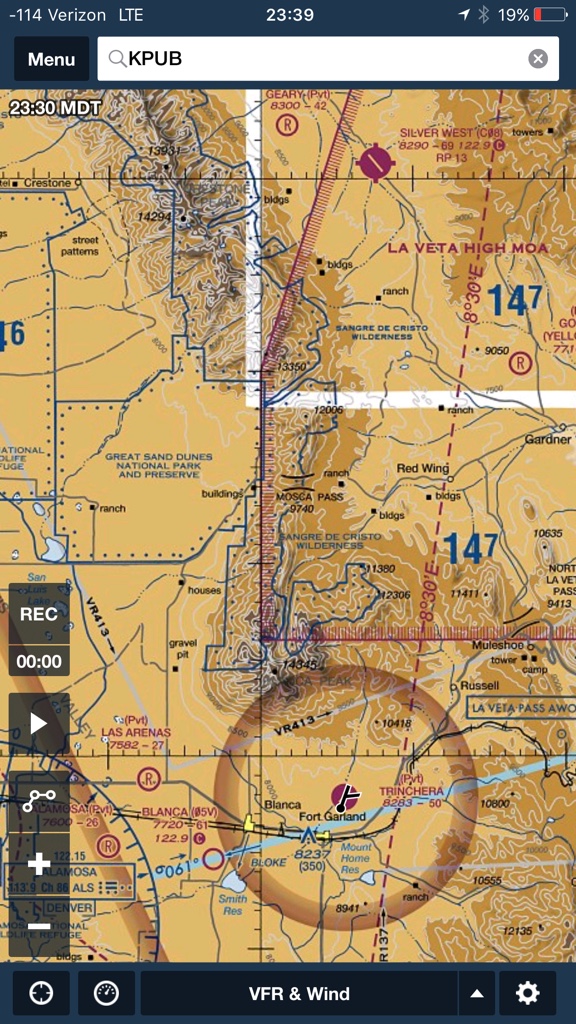Dr J....i know the request was for routes, but more info needed here for useful advice. Is your 6 a 260 or 300? Heavy or light load? Long one day or RON? Leg lengths planned? As noted above, amount of mtn experience is unknown. Are you familiar with mixture management for high DA takeoffs? do you have XM ADS-B wx available?
I'll do my best here in generalities. I usually get change from my $.02 worth....it would be nice in the profile section to have access to experience levels etc to not make these replies insulting.
The route across S WY is definitely one that is suggested/flown by people venturing west for the first time who want to avoid the jagged granite of Colorado. Re S route, I don't know how far S you consider "South", but depending on your experience and desire for tighter terrain contours, there are routes through Pueblo to Gunnison to Grand Junction, then I-70 to I-15 and N to SLC or cut over from I-70 to Price UT to Provo and SLC. Mtn pass AWOS for Monarch pass and Cottonwood Pass would be helpful for this option. Another option from further N in the Denver area is Kenosha pass to Breckinridge to join I-70 near Vail pass and then basically Eagle, Rifle and join the route above. My preference on this route is 14,500 or higher and pick up mtn top winds from Copper Mtn AWOS.(CCU) and Sunlight Basin near Glenwood Springs (5SM) Next consideration out of the DEN area is Corona/Rollins Pass W of Boulder (pass is~12,000') then fly the wide open valley to Kremmling, turn NW to Rabbit Ears Pass near Steamboat Springs (~9600' high without as much sharp terrain as Corona) then Yampa river valley to Craig, Vernal, SLC. Helpful Mtn AWOS would be Berthoud Pass(0CO...ZERO CO) and MT Werner/ Walton pk (CO7)Near Steamboat. as mentioned above in another post, wx will likely be the factor that makes you choose one of these over the other.
For altitude needed, WY is lowest route. Corona pass route allows the quickest descent to 12.5 after crossing, but depending on winds, I like to cross ~14k. Kenosha, Breck, Vail would keep me at 14.5 until ~Rifle then 12.5 would work. Pueblo, monarch or Marshall pass, Gunnison route would keep me high, again around 14.5, for underlying ugly terrain until Montrose then 12.5.
For great scenery, all the southern routes would be a bit more "mtn attractive" than I-80 over WY, but that route is beautiful in a different way with wide open high desert and views N and S to mtn ranges. Having I-80 under you makes looking down more attractive.
Consider all of this as general advice since, like I said before, your experience/training/and aircraft altitude capabilities re mtn flying are all unknowns. Do any of these above routes on severe clear days, preferably early, with winds reported on the mtn top AWOS's at 30 or preferably lower. I rarely file IFR unless needed for >18k, but always get flight following from ZDV and ZLC. They are very accommodating. Below 15-16k, plan on brief periods of "radar contact lost", but don't squawk VFR/change freq unless told to to do so. Usually they will advise "expect radar contact in X miles" or "in X miles, contact Denver on X new freq". Best way to get in the system is to call DEN approach after departing a front range airport and get handoffs. Plan on headwinds on CO going west. Note the mtn top AWOS wind speed/directions being reported in real time by telephone before departure and plan your approach to, and possible emergency outs/turns, prior to crossing passes/highnridgelines, like Corona and the row of 14's W of Breckinridge particularly. With high winds from the west, all the high peaks, ridge lines and passes can have downdrafts on the lee side of many thousands of feet more than our planes can climb. Those days with high winds would lead me to suggest the WY route or using 16k as a minimum altitude for turbulence..... or stopping.
Search for CDOT Aviation AWOS (I am still riding with training wheels on this board and can't post a link). This site has a map of CO with all the AWOS sites located, and IIRC, the airport ones are differentiated from the mtn pass/tops by different colors. Many of them are not available very far out on the published VHF frequency until you're almost committed. But, they all have one minute weather available by phone call tom the listed numbers....CO Pilots Assn also used to have mtn flying advice on the site and also sponsors a mtn flying course every yr that would be a fun trip/excuse to fly W.
Re O2....use a pulse ox to determine the need for O2 use, which is usually going to be lower than the FAA regs. I aim to keep everyone's sats 90 or above. I fly so many high trips west at 16 or above that I even have an oxygen hood for my dog ..

. Also air at the mtn crossing altitudes is close to 0% humidity so drink water and stay hydrated on your longer legs.
<ramble off>...This post has gotten longer than intended. Feel free to PM or post if more info on any of these routes is desired.




